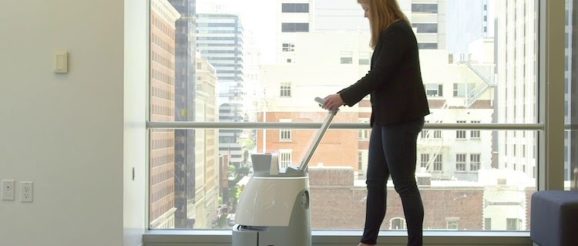Facilities management leaders call for strategic partnerships to drive robotics and innovation

With cleaning robots increasing in number and being installed in many types of buildings, a study about the future of facilities management has been published.
In the survey, it was found that the vast majority of facilities management leaders across the EMEA region believe that technology suppliers should offer performance-based contracts in order to improve the success rate of innovation projects within facility management and commercial cleaning.
New research from SoftBank Robotics EMEA, reveals that 89 percent of supply side and 78 percent of demand side facilities management leaders think that performance-based contracts are positive for the cleaning industry.
More than half (57 percent) of facilities management leaders would like to see performance-based fees, 46 percent would like gain-share models and 44 percent would like some level of commercial and operational risk-sharing when entering into a contract with a cleaning technology provider.
The research is presented in a new white paper, . The word “cobots” is a combination of the words collaborative and robots, and is used in the report to mean mainly cleaning robots such as the one developed by SoftBank Robotics.
The report highlights the need for a new approach to innovation within commercial cleaning, with 81 percent of facilities management leaders reporting that their innovation projects have failed to deliver on expected outcomes over the past two years. 66 percent state that innovation in cleaning is long overdue.
The majority of facilities management leaders believe that future innovation strategies need to be more holistic in their approach, with 76 percent stating that it is as important to innovate their business model as it is to innovate with technology.
facilities management leaders want suppliers to offer procurement models which make new technologies more accessible and affordable, and minimise their financial risk.
Seventy percent of facilities management leaders state that a leasing model that reduces their financial risk would make the adoption of new cleaning technologies more attractive. This figure rises to 73 percent within supply side organisations.
Nils van der Zijl, VP sales and marketing, SoftBank Robotics EMEA, says: “There is clearly a real appetite for partnership models within facility management and cleaning, where technology providers work closely with facility management service providers and businesses to deliver innovation, with shared goals, risks and rewards.
“It’s understandable that in an industry that has experienced significant challenges in delivering successful innovation programmes, there is a certain amount of scepticism and uncertainty when it comes to technology adoption.
“Facilities management leaders need to ensure they get the advice and support they need, working collaboratively alongside trusted partners to develop the right innovation strategies.”
The research shows that facilities management leaders are enthusiastic about the introduction of collaborative robotics into commercial cleaning.
Collaborative robots are collaborative robots which work alongside cleaning teams and undertake repetitive and time-consuming tasks such as vacuuming, freeing up staff to focus on other tasks such as the deep cleaning and sanitisation of hard surfaces which is critical in the fight against COVID-19.
As well as driving cleaning performance and operational efficiency, facilities management leaders are also attracted to the commercial model of cobotics, where cobots are deployed in a highly agile and scalable way through month-on-month operational spend.
This eliminates the need for large capital expenditure to access new technologies, one of the major barriers to innovation in the cleaning sector. Indeed, 86 percent of facilities management leaders point to the high capital expenditure involved in current cleaning approaches as a major operational challenge.
Facilities management leaders believe that the introduction of collaborative robots into their operations can deliver the technological and operational transformation they need.
Ninety-three percent report that collaborative robots will increase the quality and consistency of service delivery within commercial cleaning, 77 percent state that cobots can drive productivity, and 76 percent predict that cobotics will lead to healthier workspaces for all employees.
Innovation remains a key strategic objective within the facility management industry, with 90 percent of facilities management leaders citing it as a top business priority. It is seen as critical in attracting new customers, providing a differentiated customer experience and improving productivity.
Van der Zijl says: “Successful innovation depends on a lot more than simply having access to the very latest and most impactful technologies; it’s about developing the business models, processes, skills and understanding within the organisation to integrate new technologies in an effective and sustainable way.
“It’s crucial that facilities management leaders, whether on the demand or supply side, find strategic technology partners that can help them to implement the wider operational and cultural changes that are so critical to delivering innovation and real commercial impact.”
